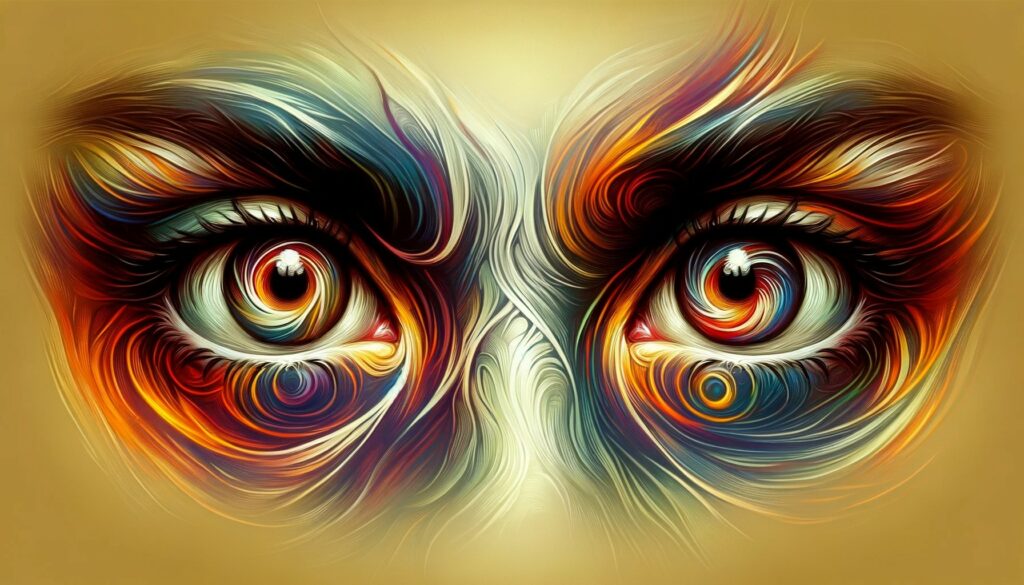Manic eyes, a term often used to describe the wild and frenzied look in someone’s gaze, can be both intriguing and unsettling. These intense eyes seem to convey a sense of restlessness and heightened energy. Whether it’s due to excitement, anxiety, or even certain medical conditions, the intensity behind manic eyes is hard to ignore.
When I encounter someone with manic eyes, it’s as if their gaze penetrates through my own thoughts and leaves me captivated by their seemingly boundless energy. It’s like witnessing a storm brewing within their soul – a whirlwind of emotions that manifests in their eyes. The rapid movements and dilated pupils add an almost hypnotic quality to their stare.
While manic eyes are often associated with mental health disorders such as mania or bipolar disorder, it’s important not to jump to conclusions based solely on appearances. Manic eyes can also be present during moments of intense focus or passion when individuals become completely absorbed in what they’re doing. Understanding the context behind these expressive gazes is crucial in order to avoid misunderstandings or assumptions.
In conclusion, manic eyes have an undeniable impact on those who encounter them. Their intensity evokes curiosity and intrigue while also reminding us of the complex range of human emotions. Whether it stems from mental health conditions or simply an individual’s passionate state of mind, these captivating gazes serve as a reminder of the depth and intricacy within each person we encounter. So let us approach them with empathy and understanding rather than judgment or fear.
Understanding Manic Eyes
Manic eyes, a term often used to describe the intense and frenzied gaze of individuals experiencing manic episodes, can be quite perplexing to observe. As someone who has studied human behavior extensively, I find myself captivated by the complexities and nuances displayed in these moments. In this section, we’ll delve deeper into understanding manic eyes and shed light on what may be going on beneath their intense exterior.
Firstly, it’s important to note that manic eyes are typically associated with bipolar disorder, a mental health condition characterized by extreme mood swings. During manic episodes, individuals often exhibit heightened energy levels and an increased sense of euphoria or irritability. These emotions can manifest in their eyes through rapid movements, widened pupils, and a distinct sparkle that seems to radiate enthusiasm.
While the exact causes behind these eye changes are not fully understood, experts believe that it could be attributed to alterations in brain chemistry. The surge of neurotransmitters like dopamine during manic episodes may contribute to the hyperactivity observed in the eyes. Additionally, studies have shown that increased blood flow and metabolic activity in certain regions of the brain could also play a role.
It’s worth mentioning that while manic eyes can be striking and indicative of an underlying condition, they should not be taken as a definitive diagnosis on their own. It is crucial for individuals displaying such symptoms to undergo proper evaluation by qualified professionals before any conclusions are drawn.
In conclusion, observing someone with manic eyes can leave us both intrigued and concerned about their well-being. By gaining insight into the underlying factors contributing to these eye changes during manic episodes, we can better comprehend the complex nature of bipolar disorder. Remember though; only trained healthcare providers can accurately diagnose and provide appropriate treatment for individuals dealing with this condition.
Sources:
- National Institute of Mental Health (NIMH)
- Mayo Clinic
Causes of Manic Eyes
When it comes to understanding the causes of manic eyes, it’s important to explore a range of factors that can contribute to this phenomenon. While manic eyes are often associated with mental health conditions such as bipolar disorder or mania, there can be other underlying causes as well. Let’s delve into some potential reasons why individuals may exhibit this intense and wide-eyed expression.
- Bipolar Disorder: One of the primary culprits behind manic eyes is bipolar disorder. This mental health condition is characterized by extreme mood swings, including episodes of mania where individuals experience heightened energy levels, racing thoughts, and increased activity. During these manic episodes, people often display symptoms such as dilated pupils and rapid eye movements, which can give their eyes a distinct “manic” appearance.
- Stimulant Use: Another possible cause for manic eyes is the use of stimulant drugs like amphetamines or cocaine. These substances can stimulate the central nervous system and induce states of hyperactivity and euphoria. As a result, users may exhibit dilated pupils and an intense gaze due to the heightened arousal caused by these drugs.
- Sleep Deprivation: Lack of sleep can also contribute to the development of manic eyes. When we don’t get enough restorative sleep, our bodies become fatigued and our brain function becomes compromised. This exhaustion can lead to a state resembling mania, where individuals may appear wide-eyed and frenetic due to their body’s attempt to compensate for the lack of energy.
- Thyroid Disorders: Certain thyroid disorders such as hyperthyroidism (overactive thyroid) or Graves’ disease (an autoimmune disorder) can manifest symptoms similar to those seen in manic episodes. These conditions affect hormone production in the body and can lead to increased energy levels, restlessness, anxiety, and consequently affect eye appearance.
- Intense Emotions: Strong emotions like excitement, fear, or anxiety can cause the eyes to appear wide and intense. When we experience heightened emotional states, our bodies release adrenaline, which can dilate our pupils and make our eyes seem more prominent.
It’s essential to note that while these are common causes associated with manic eyes, it is always best to consult a healthcare professional for an accurate diagnosis. Understanding the underlying reasons behind this phenomenon can aid in effective treatment and management of any related conditions.
Symptoms and Signs of Manic Eyes
Manic eyes, also known as “wild eyes” or “crazy eyes,” can be characterized by a distinct set of symptoms and signs. These indicators may vary in intensity from person to person but are commonly associated with individuals experiencing manic episodes. Here are a few key symptoms and signs to look out for:
- Intense Energy: One of the primary characteristics of manic eyes is an overwhelming sense of energy. The individual’s eyes may appear unusually bright, wide open, darting around rapidly, and seemingly unable to focus on one thing for too long. This high level of energy is often accompanied by an increased talkativeness and restlessness.
- Rapid Thoughts: Another prominent sign is racing thoughts that seem to jump from one topic to another without pause. This mental hyperactivity can manifest in their eye movements as well – you might notice their gaze constantly shifting, giving off a sense of constant stimulation.
- Elevated Mood: People with manic eyes often exhibit an elevated mood or euphoria that goes beyond what is considered normal range. Their eyes may reflect this heightened emotional state, appearing cheerful, animated, and even somewhat mischievous at times.
- Impulsivity: Alongside the energetic behavior, impulsivity is a common trait associated with manic episodes. Individuals experiencing this may display impulsive actions driven by their intense emotions or racing thoughts which can be reflected in their restless eye movements.
- Decreased Need for Sleep: A significant symptom seen in those with manic eyes is a decreased need for sleep or even complete insomnia during these episodes. Their wide-awake appearance can be striking as they exhibit little signs of fatigue despite getting minimal rest.
It’s important to note that while these symptoms can indicate the presence of mania, it’s always best to consult with a medical professional for an accurate diagnosis and appropriate treatment plan.
Effects of Manic Eyes on Daily Life
Manic eyes, with their intense and frenzied gaze, can have a significant impact on one’s daily life. Here are a few examples of how these manic eyes can affect individuals in their day-to-day activities:
- Social Interactions: When someone has manic eyes, it can be challenging for them to engage in normal social interactions. The intensity of their gaze may make others feel uncomfortable or even intimidated, causing potential barriers in forming connections and building relationships.
- Work Performance: In the workplace, having manic eyes can hinder productivity and collaboration. It may be difficult for individuals with this condition to focus on tasks at hand or maintain steady eye contact during meetings or presentations. This could lead to misunderstandings or missed opportunities for professional growth.
- Emotional Well-being: Living with manic eyes can take a toll on one’s emotional well-being. Constantly feeling hyperaware and overwhelmed by stimuli around them, individuals may experience heightened anxiety levels and struggle with regulating their emotions effectively.
- Perception by Others: People with manic eyes may face judgment or misconceptions from others who do not understand the condition fully. They might be perceived as erratic or unpredictable due to their intense gaze, which could lead to exclusion or isolation from social circles.
- Personal Safety: Manic eyes can also pose challenges concerning personal safety. The inability to control one’s gaze might cause difficulties navigating busy streets or potentially hazardous environments where split-second decisions are crucial.
It is important to note that the effects of manic eyes vary from person to person and depend on various factors such as individual coping mechanisms and support systems in place.
Understanding these effects allows us to approach individuals with empathy and compassion rather than making assumptions based solely on external appearances. By promoting awareness and acceptance, we create an environment where those affected by manic eyes can navigate daily life more smoothly while receiving the understanding they deserve.
Diagnosing Manic Eyes
When it comes to diagnosing manic eyes, there are several key factors that professionals consider. While I’m not a medical expert, I can provide some general information on the subject.
- Observation: One of the primary methods used in diagnosing manic eyes is through careful observation of the individual’s eye movements and behaviors. Mental health practitioners may look for signs such as rapid or frenzied eye movements, an intense gaze, or difficulty maintaining eye contact.
- Patient History: Gathering a comprehensive patient history is crucial in understanding the context behind manic eyes. Professionals will typically inquire about any previous episodes of mania or hypomania, as well as any family history of mood disorders. This information can help paint a clearer picture and aid in accurate diagnosis.
- DSM-5 Criteria: The Diagnostic and Statistical Manual of Mental Disorders (DSM-5) provides guidelines for diagnosing various mental health conditions, including bipolar disorder. It outlines specific criteria that must be met for an official diagnosis. For identifying manic eyes, professionals would assess if the individual exhibits other symptoms associated with mania, such as elevated mood, reduced need for sleep, increased energy levels, and impulsive behavior.
- Collaboration: Diagnosing manic eyes often involves collaboration between different healthcare professionals such as psychiatrists, psychologists, and ophthalmologists. This interdisciplinary approach ensures a more holistic evaluation and helps rule out any underlying medical conditions that may mimic manic symptoms.
- Differential Diagnosis: Sometimes other conditions can present with similar eye-related symptoms resembling mania but have different underlying causes altogether. It’s important for clinicians to consider alternative diagnoses like drug-induced psychosis or certain neurological disorders before settling on a diagnosis of manic eyes.
Remember that only qualified healthcare providers should make an official diagnosis based on their expertise and thorough evaluation process. If you suspect someone may be experiencing manic eyes or any related symptoms indicative of a mood disorder, it is crucial to seek professional help for an accurate diagnosis and appropriate treatment.
Treatment Options for Manic Eyes
When it comes to addressing the symptoms of manic eyes, there are several treatment options available that can help individuals manage their condition effectively. It’s important to note that the appropriate treatment plan may vary depending on the underlying cause and severity of the manic eyes. Here are a few examples of treatment options that may be considered:
- Medication: In some cases, medication can play a crucial role in managing manic eyes. Antipsychotic medications or mood stabilizers may be prescribed by a healthcare professional to help regulate mood and reduce symptoms associated with mania. It’s essential to work closely with a doctor to find the right medication and dosage for each individual.
- Psychotherapy: Therapy sessions, such as cognitive-behavioral therapy (CBT), can provide valuable support for individuals experiencing manic eyes. CBT aims to identify and modify negative thought patterns and behaviors, helping individuals gain control over their emotions and manage any accompanying distress.
- Lifestyle changes: Adopting healthy lifestyle habits can contribute significantly to managing manic eyes. Regular exercise, sufficient sleep, stress reduction techniques like meditation or yoga, and maintaining a balanced diet can all positively impact mood stability.
- Support groups: Engaging in support groups or seeking out peer support from others who have experienced similar challenges can be immensely helpful for individuals with manic eyes. Sharing experiences, coping strategies, and obtaining validation within a supportive community can aid in navigating this condition.
- Alternative therapies: Some individuals find relief through complementary approaches such as acupuncture, herbal remedies (St John’s wort), or mindfulness practices like deep breathing exercises or progressive muscle relaxation techniques.
It is important to remember that finding an effective treatment plan often involves trial-and-error under the guidance of medical professionals specializing in mental health conditions like manic eyes.
By exploring these various treatment options alongside healthcare providers, individuals with manic eyes can strive towards achieving symptom management while enhancing overall well-being. Remember, everyone’s journey is unique, and what works for one person may not work for another. It’s crucial to find an individualized approach that addresses specific needs and preferences for the best possible outcome.
Managing Manic Eye Symptoms at Home
When it comes to managing manic eye symptoms at home, there are a few strategies you can try. While it’s important to consult with a medical professional for proper diagnosis and treatment, these tips may help alleviate some of the discomfort associated with manic eyes:
- Rest your eyes: Taking regular breaks and ensuring adequate rest for your eyes can be beneficial. Close your eyes for a few minutes throughout the day or try using soothing eye pads to provide relief.
- Apply cold compresses: Placing a cold compress over your closed eyelids can help reduce any swelling or inflammation that may occur during manic episodes. Be sure to wrap the compress in a clean cloth before applying it to avoid direct contact with your skin.
- Practice good eye hygiene: Keeping your eyes clean is essential when dealing with manic eye symptoms. Use mild, non-irritating cleansers specifically designed for the delicate eye area to remove any debris or irritants that could exacerbate the condition.
- Avoid triggers: Pay attention to any factors that seem to worsen your manic eye symptoms and try to avoid them as much as possible. This could include exposure to bright lights, excessive screen time, or certain allergens.
- Use lubricating eye drops: Dryness and discomfort often accompany manic eyes, so using lubricating eye drops can provide temporary relief by moisturizing the surface of your eyes.
Remember, while these strategies may offer some relief, they are not meant as substitutes for professional medical advice or treatment options prescribed by healthcare providers. If you experience persistent or severe symptoms, it’s crucial to seek guidance from an ophthalmologist or optometrist who can assess your condition thoroughly.
By incorporating these self-care practices into your routine and working closely with healthcare professionals, you can take proactive steps towards managing manic eye symptoms effectively from the comfort of your own home.
Preventing Recurrence of Manic Eyes
When it comes to preventing the recurrence of manic eyes, there are several strategies that can be helpful. Here are a few examples:
- Establishing a consistent sleep routine: Proper sleep is crucial for maintaining stable mood and preventing manic episodes. By going to bed and waking up at the same time every day, you can help regulate your body’s internal clock and promote better sleep patterns.
- Managing stress levels: Stress can trigger or exacerbate manic symptoms. It’s important to find healthy coping mechanisms such as practicing mindfulness, engaging in regular exercise, or seeking support from friends, family, or a therapist.
- Sticking to a balanced diet: A well-balanced diet rich in fruits, vegetables, whole grains, lean proteins, and healthy fats can provide the essential nutrients your brain needs for optimal functioning. Avoiding excessive caffeine or alcohol intake may also help maintain stability.
- Taking prescribed medications as directed: If you’ve been diagnosed with bipolar disorder and have been prescribed medication by your healthcare provider, it’s crucial to take them consistently and follow their instructions closely. Medications play a significant role in managing bipolar symptoms and reducing the likelihood of recurring manic episodes.
- Regularly attending therapy sessions: Therapy can provide valuable tools and techniques for recognizing early warning signs of mania and developing effective coping strategies specific to your individual needs.
Remember that everyone’s experience with bipolar disorder is unique, so it’s essential to work closely with your healthcare provider to develop a personalized plan for preventing the recurrence of manic eyes.
Preventing the recurrence of manic eyes requires a multifaceted approach that includes establishing good sleep habits, managing stress levels effectively through various techniques like mindfulness or exercise, maintaining a balanced diet rich in essential nutrients while limiting caffeine and alcohol consumption when possible, adhering faithfully to prescribed medications under medical supervision,and attending therapy sessions regularly for additional support tailored specifically towards your needs. By implementing these strategies, you can increase the likelihood of maintaining stability and reducing the frequency and intensity of manic episodes.



